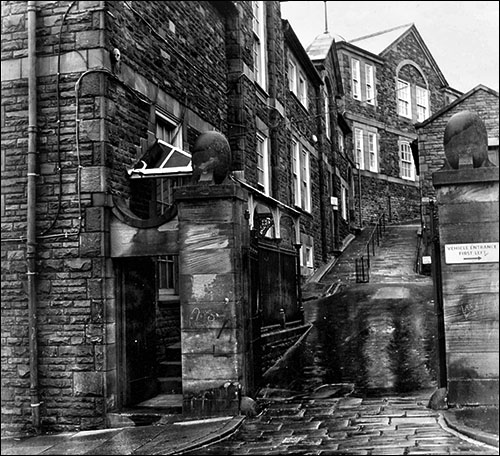Former Swansea workhouse, Mount Pleasant
The Old Hospital residential complex, owned by Coastal Housing Group, occupies the former workhouse, where poor people lived but had to work for their upkeep. The buildings later formed the Mount Pleasant Hospital. The old photo, courtesy of West Glamorgan Archive Service, shows a pedestrian entrance at the bottom end of the site.
 Local parishes helped their paupers until the law changed in 1834 and parishes grouped together in “Unions”. In 1837 the Swansea Union’s guardians of the poor considered whether to build a new workhouse but decided the “present Swansea House of Industry is sufficiently extensive”.
Local parishes helped their paupers until the law changed in 1834 and parishes grouped together in “Unions”. In 1837 the Swansea Union’s guardians of the poor considered whether to build a new workhouse but decided the “present Swansea House of Industry is sufficiently extensive”.
A new workhouse, fit for the district’s growing needs, was authorised in 1851 but not completed for over a decade. It had space for more than 300 inmates. Later additions almost doubled the capacity, and the workhouse’s infirmary was rebuilt in 1902. The water supply came from further up Gibbet Hill, as this hillside was known.
In 1907 14 families, with 61 children between them, went to the workhouse because they couldn’t find affordable homes. The board of guardians said there were no unoccupied homes available in Swansea, and house overcrowding was rife.
Many child inmates had been deserted by, or had lost, one or both parents. One night in 1897, four children from Brynmill – aged three to eight years – asked for admission to the workhouse. Their mother had sent them. One was “black and blue” from ill-treatment. In 1899 veterinary surgeon JW Hopkin was ordered to pay the workhouse 2s 6d maintenance a week for each of the three children he’d fathered with inmate Ellen Jones.
Despite the harsh workhouse life, some inmates survived well beyond average life expectancy. Midwife Jane Jones lived in the workhouse when the 1881 census recorded her age as 99. She was still living here aged 105. In 1899 William Thomas (“Billy Doms”) died aged 100 at the workhouse, where his daughter (70) and son (62) also lived. He’d once earned a living selling hay and slaughtering animals for farmers. Robert Phillips was 102 years old when he died in 1910 at the workhouse, where he’d lived for 16 years.
Mary Norman, nicknamed “Lady Tichborne”, was 87 when she died here in 1907 after a chaotic and drunken life. She’d received her 99th criminal conviction in 1893.
In 1904 a woman in her 80s chose to stay at the workhouse after inheriting a large amount of money.
The First World War brought further inmates to the workhouse. The three children of Lance Corporal William Morris, who died in action in 1916, became orphans here in 1919. Their mother Margaret had moved here with them after falling ill while working in Pembrey’s toxic munitions factories. In March 1919 the Comrades of the Great War arranged a military funeral for workhouse inmate Corporal Henry Charles Dawson, 37.
The old workhouse was an NHS hospital after the Second World War and converted into housing association accommodation by the end of the century.
Postcode: SA1 6XN View Location Map
With thanks to West Glamorgan Archive Service. Sources include the National Library of Wales


